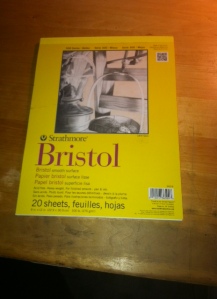I’ve been asked by a number of people what my process is for creating my “Spectickles” cartoons. While I do some cartoon work on the iPad, “Spectickles” is all old school. Here it is in a nutshell:
Coming Up With the Gag
Now that “Spectickles” is syndicated and in newspapers, I have to generate lots of ideas – at least one a day. I’ll share some of the most effective tools I’ve found for doing that. I’ve mentioned it a number of times in the past, but the number one resource I turn to very, very frequently to get the ideas going is New Yorker cartoonist Mischa Richter’s “The Cartoonist’s Muse” – probably the single best method for going from a blank piece of paper to a well developed gag.
I’m a HUGE fan of Jack Markow’s books, particularly his, “Cartoonist’s and Gag Writer’s Handbook”. Jack was a magazine cartoonist at a time when you could make a very handsome living submitting to the seemingly endless list of magazines seeking single panel gags.
The book itself is a joy to read, but most useful to me is his “Jumble of Ingredients” pages which provides lists broken up into three columns: People, Places, and Props. You start out by taking a word from one of the columns, add something from another column, and let your mind wander and begin to make connections. Before you know it, you’ve got one or more gags.

You know the little yellow sticky notes you often find in office cubicles to remind you of things? I use them for thumbnail sketches of gag ideas. Not all ideas I come up with are good enough or thought through sufficiently to begin penciling on Bristol, but having a large cache of these ideas can stimulate ideas, and some, with a little help from the muse (and by muse, I am of course referring to wine), can be tweaked into a usable gag.
Penciling
Once I have my gag ready, it’s time to move to Bristol. Not the city, the paper. Although I hear Bristol’s quite nice. But I digress. I use 9″x 12″ 300 series smooth surface Bristol. You can buy Bristol with more “tooth” or a coarser surface, but I prefer the smooth for inking with a fountain pen.
I draw “Spectickles” 7 inches square. Why? Because I once read that’s how it was supposed to be done, although I can’t find the source where that came from, it seems to have worked out pretty well across a spectrum of markets, including newspapers. Since I have to create the 7″ box virtually countless times, I took a piece of 1/8″ thick aircraft plywood, found an old round drawer handle, drilled and countersunk a hole in the center for a flathead screw, and voila! (that’s French), I had a faster, consistent way to draw the box.
The pencil I’ve used for many yeas is a Rotring mechanical pencil with 0.5 lead. It’s metal, heavy and comfortable for me to sketch with.
Inking
I don’t know why, but to me, this is one of the real joys of cartooning. Charles Schulz would speak so eloquently of the importance of line work. Slight variations in thickness at just the right point gives a drawing such life and fluidity. I’ve used a number of different drawing tools over the years; dip pens with a variety of different nibs, mechanical drafting pens – you name it. But for some time now I’ve used an old Pelikan fountain pen with (I believe) an M250 nib. The line is a bit thicker and with a little more pressure as I draw, I’m able to get a line variation I can be happy with, and overall I’m pleased with the results.
Scanning
I don’t know if it’s rated good or bad, but it’s worked great for me – my Epson Artisan 710 scanner, printer, and other stuff thingy. I scan black and white at 300 dpi, which is then imported into Photoshop for formatting, coloring and lettering.
Coloring
All color work is completed in Photoshop. I’m thinking of doing a blog entry on that alone – let me know if you think it’s worth it.
Drinking Wine
I look way smarter when I hold a glass of wine in my hands. Also, in my mind, after a couple glasses of cabernet, I’m way funnier. Waaaaaaaaay funnier. Although I tend to be the only one laughing. Awkward.
Next up: How I create my “Percenters” business cartoons as seen in publications like the Wall Street Journal, Harvard Business Review, Prospect and others – stay tuned!







I like the drinking wine part, Bill :-)
i have a brother who lives in texas who does art free hand. is that how you started
Hi Chris – it is how I started and how I still draw – all freehand. Thank you for your question!